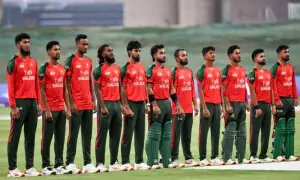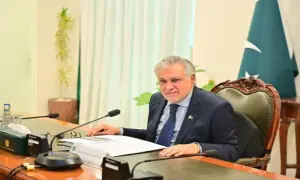UK economist proposes sweeping reforms to boost Pakistan’s growth, exports
The UK-based economist Stefan Dercon has proposed a radical reform plan for Pakistan to address the country’s challenges of low growth and low exports.
Dercon presented this home-grown economic growth plan to the Pakistani government’s economic team.
The key elements of Dercon’s proposal are to stimulate private investment rather than relying primarily on import substitution, to prioritize exports as a strategy for driving economic growth rather than simply substituting imports, and to optimize public investment to better support and enable the desired economic growth.
Dercon highlighted that low growth and low exports are major structural issues for Pakistan, and that implementing these reforms is necessary to create new growth and employment opportunities, particularly given the large number of young people entering the labor market each year who the current economic model is unable to adequately accommodate.
Dercon believed that undertaking these reforms now would lend credibility to Pakistan’s efforts, especially given the ongoing IMF program that is focused on stabilization.
According to Dercon’s plan, there are no quick fixes or “silver bullets” to Pakistan’s economic challenges. Instead, the focus should be on implementing sensible reforms that have, for various reasons, not been carried out in the past. Crucially, the success of this reform agenda will depend on securing buy-in and commitment from all key stakeholders, including the business community, policymakers, the political establishment, and other relevant parties.
Delivering on this reform plan will require a comprehensive, “whole of government” approach, coordinated by the Prime Minister’s Office. This will involve establishing feedback loops, regular monitoring and assessment, and a willingness to learn and adapt the approach as needed.
Dercon’s radical reform agenda centers around three key pillars with all while maintaining macroeconomic and banking sector stability, with a market-based exchange rate.:
- stimulating private investment
- promoting exports rather than import substitution
- optimizing public finance
To stimulate private investment, Dercon suggests creating the right conditions for both Pakistani and international businesses to invest more, by reducing bureaucratic hurdles and ensuring a level playing field that encourages fair competition.
The plan for stimulating exports proposed that a shift in Pakistan’s economic model away from protectionism and import substitution, and towards export promotion. This would involve significantly reducing import tariffs over the next three years to levels more comparable to Pakistan’s competitors, with a target reduction of around five percentage points.
These tariff reductions would focus specifically on intermediate inputs that can directly support export industries. The government’s efforts on tariffs would also be integrated with other measures aimed at driving export diversification, such as in the agriculture, IT, and non-traditional manufacturing sectors, as well as efforts to better integrate Pakistan into global value chains.
The plan also outlined proposals for optimizing public finance in Pakistan. This includes bringing government debt and deficits under control, while also adopting a more pro-growth approach. This would involve creating a dedicated policy unit within the Ministry of Finance to annually assess the economic impact of all tax policies, energy tariffs, customs duties, and subsidies, before the annual budget is finalized.
Additionally, the plan proposed spreading the tax burden more broadly and fairly across businesses and households, including through increased digitization of the tax system. The aim is to begin bringing down the overall tax burden per taxpayer, while expanding the tax base.
The plan envisaged rapid reform of the Federal Board of Revenue (FBR) functions to improve tax collection, including through increased digitalization. It also called for reducing the footprint of the state by privatizing or better managing state-owned enterprises (SOEs). Additionally, the plan proposed right-sizing the government at both the federal and provincial levels to bring down costs and improve efficiency, as well as rationalizing public development expenditures, including optimizing the use of public-private partnerships (PPPs) for development projects.
If the proposed reforms were well-executed, the plan projected that the government could create the conditions for an additional one million jobs per year by fiscal year 2028, primarily driven by the private sector. The plan also aimed to achieve GDP growth of 6% or more by 2028 without macroeconomic instability, and to boost private investment to $10 billion per year, increasing the investment share in GDP to 15% by fiscal year 2028.
Furthermore, the plan targeted an additional $20 billion in exports per year, which would increase the share of exports in GDP to 15% by 2028. It also aimed to align public finances with the ongoing IMF program, with the tax-to-GDP ratio reaching 13.5% by fiscal year 2027, and a significantly broader tax base.
Read more
Finance Minister Aurangzeb unveils Rs18.87 trillion budget amid opposition noise
For the latest news, follow us on Twitter @Aaj_Urdu. We are also on Facebook, Instagram and YouTube.




















Comments are closed on this story.